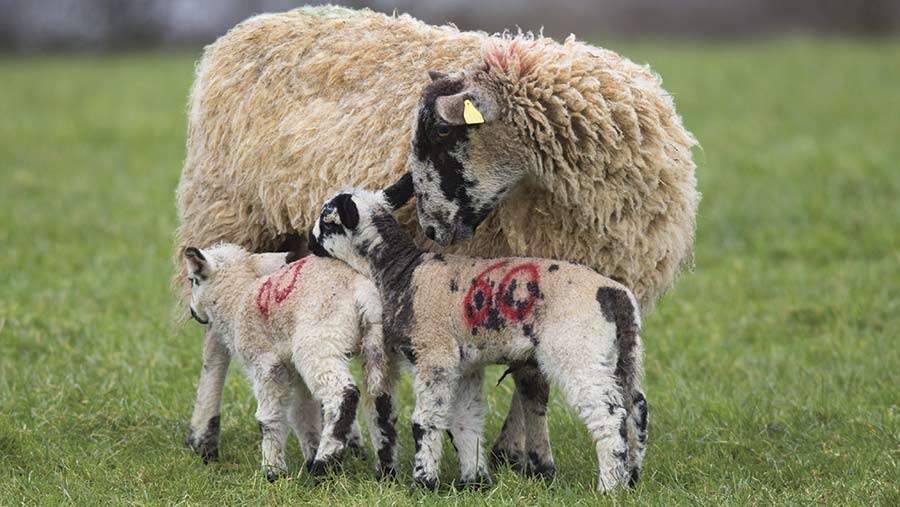Guide to getting the best from your lambs in 2017
 © Tim Scrivener
© Tim Scrivener It has been a challenging season for sheep producers with many farmers struggling to grow and finish their lambs, according to vets.
One reason was last winter’s prolonged wet weather, says vet Rosie Gibson, of Honddu Vets in Brecon.
See also: How the sheep industry plans to reduce antibiotics use
“Ewes were challenged by the weather conditions last winter and this had a prolonged effect.
“They were more run-down than usual and may not have had enough milk and quality colostrum for the lambs to get the start that is vital to lifetime productivity.”
But there are measures that can be taken to avoid a repeat of this situation in 2017, she assured lamb producers at a meeting hosted by Farming Connect in Brecon.
Maximising the performance of lambs
Mrs Gibson and Kate Hovers, a vet specialising in sheep health, advise that ewe nutrition and condition directly affect the performance of lambs, in conjunction with hygiene at lambing, vaccination, the correct trace element levels and parasite control.
Getting these right will help avoid the need for blanket antibiotic treatment for conditions such as pasteurella.
Although the sheep industry uses less antibiotics than other livestock sectors, more needs to be done to prevent diseases rather than relying on treatment, Mrs Gibson added.
“With good, basic hygiene, correct feeding and preventive medicine, we can reduce the impact of bacterial infection.”
Do’s and don’ts
Ms Hovers said vaccines rely on animals being in good health.
“If you give lambs a good start by avoiding trace element deficiencies and parasites and making sure they get the best possible nutrition, vaccinating will be effective.”
She advised against vaccinating at stressful times – weaning, dipping and shearing. And administering the correct dosage for the whole course is essential.
Correct storage is vital, at 2-8C so buy the vaccine as close to administration as possible,” said Ms Hovers.
Position vaccines in the centre of the fridge and fill up the air space, by storing bottles of water labelled “do not drink” in the fridge also.
Ewe nutrition – getting it right
Analysing silage will help farmers work out nutrition shortfalls, says Ms Hover.
It is important to keep fresh feed in front of ewes. Ewes will avoid stale silage even when they are hungry, Ms Hovers says.
“Good quality silage will need far less concentrate supplementation and may be adequate for single bearing ewes with a little protein for balance.”
Ewes must have sufficient trough space to feed – 18in a ewe for concentrate feeding is the industry recommendation with 12in for hill breeds. For true ad-lib silage, 6in a ewe is required.
If concentrates are fed, they should be given more than once a day to aid digestion, Ms Hovers stressed.
If the ewe is well fed, her lambs will be too.
Getting the best from colostrum
Good colostrum has a direct influence on weaning weights and days to slaughter.
Ensure lambs get 50ml for every kg of bodyweight as soon as possible after birth – no later than two hours – and 10% of their bodyweight in the first 24 hours.
Ideally, milk out single-bearing ewes, after the lamb has sucked, and use within 48 hours or freeze it for up to 12 months, said Ms Hovers.
Defrost slowly by standing the container in warm water – avoid using a microwave as it will destroy antibodies.
If ewe colostrum is not available, Ms Hovers recommends feeding cow colostrum. Cow colostrum has less energy than ewe colostrum so at least 10% more should be given.
Ms Hovers said if artificial colostrum is fed it should not be a sole source and should only be fed when colostrum with better protection cannot be accessed.
Managing grazing to avoid coccidiosis
All sheep carry a certain level of coccidiosis, but turning younger lambs on to pasture after older lambs will create a disease build-up.
Practice preventative medicine from the start, says Ms Hovers who advises following these key points:
- Ensure a good start for the lambs – focus on ewe condition, nutrition and avoiding neonatal disease.
- Make use of clostridial and pasteurella vaccination effectively.
- Keep on top of worm control with the safest grazing for lambs. Monitor with worm egg counts and use effective wormers where necessary.
- Pay attention to trace element supplementation, especially cobalt/B12 from eight weeks.
- Avoid and control disease such as scab, lice, lameness and fly strike.
